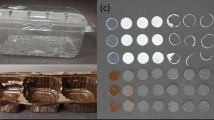Abstract
Pichia anomala 2.2540, isolated from soil contaminated by crude oil, degraded naphthalene, dibenzothiophene, phenanthrene and chrysene, both singly and in combination. The yeast degraded 4.5 mg naphthalene l−1 within 24 h. Phenanthrene was degraded after a lag of 24 h. When a mixture of all four polycyclic aromatic hydrocarbons was treated at either 0.1–1.6 mg l−1 or 3.1–5.3 mg l−1, naphthalene was completely degraded first within 24 h, followed by phenanthrene and dibenzothiophene after 48 h. Chrysene, which remained in the mixture even after 96 h, could be degraded along with naphthalene. Chrysene at 0.7 and 1 mg l−1, in the presence of 4.3 and 65 mg naphthalene l−1, respectively, was removed within 96 h.
Similar content being viewed by others
References
Andres S, Andrzej M, Christian J, Aloys H (1999) Degradation of fluorene, anthracene, phenanthrene, fluoranthene, and pyrene lacks connection to the production of extracellular enzymes by Pleurotus ostreatus and Bjerkandera adusta. Intern. Biodeterior. Biodegrad. 43: 93–100.
Bouchez M, Blanchet D, Vandecasteele JP (1995) Degradation of polycyclic aromatic hydrocarbons by pure strains and by defined strain associations: inhibition phenomena and cometabolism. Appl. Microbiol. Biotechnol. 43: 156–164.
Cerniglia CE (1992) Biodegradation of polycyclic aromatic hydrocarbons. Biodegradation 3: 351–368.
Chaineau CH, Morel JL, Oudot J (1995) Microbial degradation in soil microcosms of fuel oil hydrocarbons from drilling cuttings. Environ. Sci. Technol. 29: 1615–1621.
Kurtzman CP, Robnett CJ (1998) Identification and phylogeny of ascomycetous yeasts from analysis of nuclear large subunit (26S) ribosomal DNA partial sequences. Ant. van. Leeuweenhoek 73: 331–371.
Leblond JD, Schultz TW, Sayler GS (2001) Observations on the preferential biodegradation of selected components of polyaromatic hydrocarbon mixtures. Chemosphere 42: 333–343.
McNally DL, Mihelcic JR, Lueking DR (1999) Biodegradation of mixtures of polycyclic aromatic hydrocarbons under aerobic and nitrate-reducing conditions. Chemosphere 38: 1313–1321.
Mueller JG, Chapman PJ, Blattmann BO, Pritchard PH (1990) Isolation and characterization of a fluoranthene-utilizing strain of Pseudomonas paucimobilis. Appl. Environ. Microbiol. 56: 1079–1086.
Romero MC, Cazau MC, Giorgieri S, Arambarri AM (1998) Phenanthrene degradation by microorganisms isolated from a contaminated stream. Environ. Pollut. 101: 355–359.
Romero MC, Hammer E, Cazau MC, Arambarri AM (2002) Isolation and characterization of biarylic structure-degrading yeasts: hydroxylation potential of dibenzofuran. Environ. Pollut. 118: 379–382.
Yang QX, Yang M, Pritsch K, Yediler A, Hagn A, Schloter M, Kettrup A (2003) Decolorization of synthetic dyes and production of manganese-dependent peroxidase by new fungal isolates. Biotechnol. Lett. 25: 709–713.
Author information
Authors and Affiliations
Rights and permissions
About this article
Cite this article
Pan, F., Yang, Q., Zhang, Y. et al. Biodegradation of polycyclic aromatic hydrocarbons by Pichia anomala . Biotechnology Letters 26, 803–806 (2004). https://doi.org/10.1023/B:BILE.0000025882.33234.91
Issue Date:
DOI: https://doi.org/10.1023/B:BILE.0000025882.33234.91




